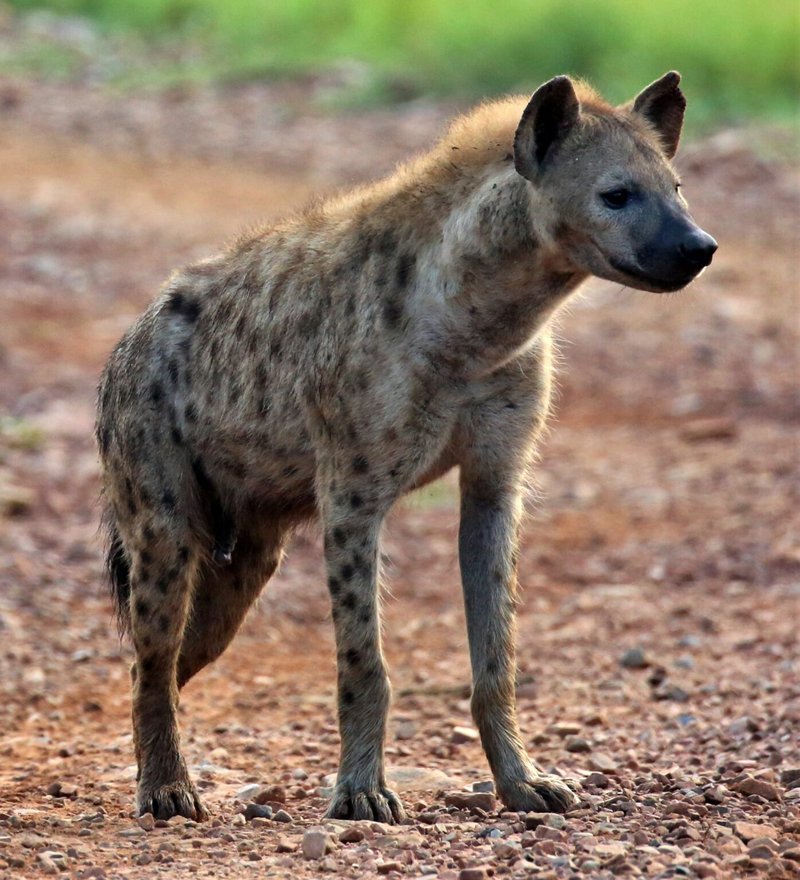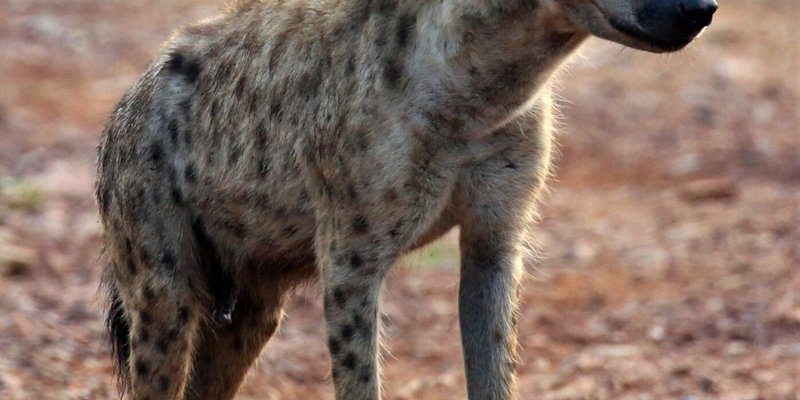
Imagine you’re trying to identify your favorite pizza toppings at a crowded party. You know what you like, but sometimes you mix up the pepperoni with the salami, right? Just like that, spotting these animals in the wild can leave you scratching your head. So, let’s explore ten animals similar to the spotted hyena—and by the end, you’ll be a pro at telling them apart!
1. Brown Hyena
The brown hyena is often overshadowed by its spotted cousin, but it’s equally fascinating. Unlike the spotted hyena, which has a more robust build and larger ears, the brown hyena has a lankier appearance with a shaggy, brownish coat. This unique coloration helps it blend into the dry terrains of southern Africa, where it roams primarily at night.
One of the most distinguishing features of the brown hyena is its rounded ears. When you see a hyena with longer, more pointy ears, chances are you’re looking at a spotted one. You might also notice that brown hyenas tend to be more solitary than their spotted relatives, often scavenging alone rather than hunting in packs. If you’re ever lucky enough to spot them, observe how they stealthily scavenge for food, using their keen sense of smell to sniff out carrion.
2. Striped Hyena
Next up is the striped hyena, primarily found in North and East Africa as well as parts of Asia. As the name suggests, this hyena has a distinctive striped coat that sets it apart from its spotted cousins. With its smaller size and more slender body structure, the striped hyena’s appearance is a bit more agile compared to the robust spotted hyena.
A cool fact about the striped hyena is its strong sense of smell, which is critical for locating food in its arid environment. They mostly feed on carrion, but they can also hunt small animals. The stripes on their body, especially on the legs and back, are not just for show; they help with camouflage in their rocky habitats. If you visualize a spotted hyena and then see a striped one, you’ll immediately recognize the difference thanks to their unique fur patterns.
3. African Wild Dog
The African wild dog is another fascinating creature that might confuse folks at first glance. While they don’t belong to the hyena family, their social behaviors and hunting tactics align with those of spotted hyenas. Known for their remarkable pack behavior, African wild dogs are highly social animals that hunt in coordinated packs in search of prey.
What really sets them apart is their unique coat pattern. Unlike hyenas, African wild dogs have a patchy coat of browns, blacks, and whites—a striking difference that’s easy to spot. Their large, rounded ears serve as a distinct feature too. When observing their behavior, you’ll notice how the dogs communicate with each other using body language and vocalizations—a trait shared with hyenas. This social structure is crucial for their survival, emphasizing teamwork in hunting.
4. Cheetah
You might not think of the cheetah as a hyena look-alike, but they share some similarities in their habitats. Cheetahs are built for speed with their sleek bodies, while hyenas tend to be more robust and powerful. However, they often inhabit the same regions, and both can be seen scavenging or hunting in the wild.
One important distinction is their hunting style; cheetahs are solitary hunters, relying on their speed to take down prey, while spotted hyenas are more likely to hunt in groups. Cheetahs have a distinctive black “tear mark” under their eyes, which helps reduce glare while they sprint. If you see a swift and slender animal sprinting across the savanna, it’s likely a cheetah rather than a hyena!
5. Jackal
The jackal is often associated with hyenas due to their scavenging behavior. They are smaller and more agile than spotted hyenas, often found in pairs or small family groups. Jackals have a slender build and a bushy tail, and their fur is typically a mix of brown and black, with a lighter underbelly.
When you spot a jackal, pay attention to its size and behavior. Unlike hyenas, which often scavenge in larger groups, jackals are more likely to hunt smaller animals or scavenge leftovers. Their nimble nature allows them to quickly dash away when threatened, making them quite elusive. If you ever hear a series of yaps or howls, you might just be in jackal territory!
6. Dingo
The dingo, native to Australia, is often considered a wild dog but shares behavioral traits with hyenas. Dingoes are adaptable and usually hunt in small packs, showcasing a level of social structure similar to spotted hyenas. However, they typically have a leaner appearance and a shorter snout.
One of the major differences is their environment; dingoes thrive in diverse habitats, from deserts to forests. Their coat is usually a mix of tan and white, making them look different from the striking spots of the hyena. You might be wondering how to identify them in the wild. Look for the dingo’s signature curled tail and its more dog-like ears compared to the hyena’s larger, upright ears.
7. Tasmanian Devil
The Tasmanian devil may seem like an odd comparison, but these creatures are often mistaken for small hyenas due to their similar scavenging habits. Found only in Tasmania, they have a stocky build and a dark coat with a white patch on the chest, giving them a unique appearance.
While they might not laugh like hyenas, Tasmanian devils are known for their loud screeches and growls, which can be quite eerie at night. When comparing the two, you’ll notice that while hyenas have longer legs and a more elongated body, Tasmanian devils are more compact. If you ever encounter one, watch how they scavenge for carrion much like their larger cousins—their role in the ecosystem is essential for keeping things clean.
8. Kudu
Although the kudu isn’t a carnivore like the spotted hyena, it’s an important part of the same ecosystem. Kudus are large antelopes with impressive spiral horns and striking coat patterns, making them visually similar in the sense that both live in similar habitats. They often coexist with hyenas, providing them with potential prey.
Kudus are herbivores and mostly graze on leaves and shrubs, unlike hyenas that thrive on meat. If you spot a kudu, take note of its graceful stature and the way it blends into its surroundings. The kudu’s large, dark eyes also help with its keen sense of sight, making it easy to spot danger—a skill that can benefit both the kudu and any nearby hyenas scavenging after a hunt.
9. Warthog
Next on the list is the warthog, another species you might encounter alongside spotted hyenas in the African savanna. Warthogs are easily recognizable due to their tusks and bristly hair, which give them a rugged appearance. Unlike hyenas, they primarily eat grass, roots, and fruits.
Warthogs are often found foraging on all fours, and when startled, they’re known to run away with their tails held high, creating a comical silhouette. While they share habitats with spotted hyenas, they occupy a totally different niche in the ecosystem. If you ever spot a warthog, try not to laugh at their antics—they can be quite entertaining!
10. Lion
Last but certainly not least is the lion. Both hyenas and lions are apex predators in their habitat, often competing for food. While lions are easily recognized by their majestic manes and powerful bodies, they share some similar characteristics with hyenas, especially in their social structures and hunting styles.
Lions tend to hunt in groups, much like hyenas do, and are known for their cooperative hunting strategies. However, lions are larger and generally more powerful, whereas hyenas are often underestimated despite their strength. When observing these two, focus on their social interactions; lions roar to establish territory while hyenas engage in their unique laughs and vocalizations.
In summary, while the spotted hyena has its distinctive traits, several other animals share similar habitats or traits. From the brown and striped hyenas to other scavengers like jackals and warthogs, each has a unique role in maintaining balance within their ecosystems. Understanding these differences helps us appreciate the diverse tapestry of wildlife in the world. So next time you’re out in nature or watching a documentary, you can impress your friends by identifying these fascinating creatures and their unique traits!

